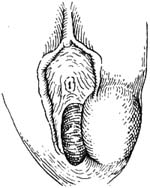| disease | Bartholinitis |
| alias | Barlholinitis |
The Bartholin's glands are located at the posterior part of the labia majora on both sides, with their ducts opening near the hymen on the inner side of the labia minora. Due to their anatomical location, pathogens can easily invade and cause inflammation during sexual intercourse, childbirth, or other situations that contaminate the vulva.
bubble_chart Etiology
Bartholinitis mostly occurs during the childbearing years and is rare in infants and postmenopausal women. The pathogens are mostly staphylococci, Escherichia coli, streptococci, and enterococci, with a few cases caused by gonococci.
bubble_chart Clinical Manifestations
During the acute phase, there is localized pain and redness, with the most severe pain occurring when a Bartholin's gland abscess forms. Fever is common, while shivering is less frequent. Difficulty in urination and defecation may sometimes occur. Clinical examination may reveal a red, swollen, and hard mass in the lower one-third of the labia majora, with significant tenderness. If it has developed into an abscess, it usually appears as a mass the size of an egg to an apple, often unilateral (Figure 1). The skin over the mass is red and thin, with surrounding tissue edema. In severe cases of inflammation, it may spread to the perineum and the contralateral vulva. Local tenderness is significant, with a sense of fluctuation, and the inguinal lymph nodes are often swollen.

Figure 1 Bartholin's gland abscess
Based on the medical history and local appearance along with digital examination, the diagnosis is generally not difficult. However, attention should also be paid to any abnormalities in the urethral orifice and paraurethral glands. Due to severe pain, a vaginal speculum examination is not feasible, and if not necessary, it may be temporarily avoided. Typically, secretions should be collected from the openings of the greater vestibular glands, the urethral orifice, and the paraurethral glands for smear tests to identify pathogenic bacteria.
bubble_chart Treatment MeasuresDuring the acute phase, absolute bed rest is essential, with attention to local cleanliness, local cold compresses, and the application of antibiotics. If an abscess has formed, it should be incised and drained immediately. The incision should be made at the thinnest part of the skin, typically on the inner side of the labia majora, creating a semi-arc incision to expel pus. Alternatively, after disinfecting the vulva, an 18-gauge needle can be inserted from the mucosal side into the abscess cavity to aspirate the pus. The needle is left in place, and 200,000 to 400,000 units of penicillin in saline are slowly injected. After removing the needle, apply pressure with gauze or a cotton ball for several minutes to prevent the medication from leaking out, and secure with a vulvar pad and a menstrual belt. Inflammation usually subsides within 24 hours after this treatment, and pain is alleviated. If the effect is not significant, proceed with incision and drainage. Various methods for treating Bartholin's gland cysts can also be applied, as discussed in the following section.
When the abscess is deficient, it may spread posteriorly, forming a perirectal abscess, and sometimes even rupturing into the rectum.
After the abscess is incised and pus is expelled, most abscess cavities can completely close and heal, but occasionally a fistula may form, with a small amount of discharge continuously draining. During palpation, a small, hard nodule can be felt with slight tenderness, and sometimes pus may be discharged from the fistula when squeezed. Sometimes the fistula may close or narrow on its own, leading to the accumulation of pus and the reformation of an abscess, which may recur repeatedly and become chronic.






